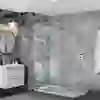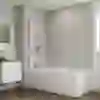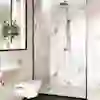Share:
If you’re tired of seeing dull and outdated walls in your bathroom, you may be looking to give this room a fresh new look. One easy way to do this without breaking the bank is by panelling. Panelling bathroom walls is an affordable and simple way to achieve a modern and stylish aesthetic. Better still, with the right tools, it’s a DIY project that can be done in as little as one weekend!
Here, The Bathroom Showroom takes you through the simple process of panelling your bathroom walls from start to finish. From selecting the right materials to prepping your walls, cutting the panels, and considering those finishing touches, we've got you covered.

What Are The Advantages of Panelling Bathroom Walls?
Panelling bathroom walls has become increasingly popular in recent years for several reasons. The biggest advantage of panelling is its affordability. Compared to other wall finishes like tiles, panelling is much cheaper. Additionally, panelling is easy to install, which means you can do it yourself, saving on installation costs. Furthermore, panelling comes in a wide range of styles and colours, making it easy to find the perfect match for your bathroom décor.
Another advantage of panelling is its durability. Bathroom walls are regularly exposed to moisture and humidity, which can cause damage to some materials. However, with the right type of panelling, you won't have to worry about water damage or mould. Panelling is also easy to clean and maintain, which makes it a great choice for busy households.
Alongside its practical benefits, panelling can also add aesthetic value to your bathroom. For many, a modern alternative to tiles, panels promote a unique style and often make a bathroom feel like a spa! Panelling can also make your bathroom appear larger and brighter, which is especially helpful if you have a small bathroom.

The Types of Bathroom Wall Panels
There are several types of bathroom wall panels to choose from. The most common types of bathroom wall panels include PVC, MDF, solid wood, and acrylic.
PVC Panels: PVC panels are made of plastic and are a popular choice for bathrooms because they are waterproof and easy to clean. PVC panels come in various colours and designs, so you can choose the one that suits your bathroom décor.
MDF Panels: MDF (medium density fiberboard) panels are made of wood fibres and resin, and are a more affordable option than solid wood panels. MDF panels are easy to cut and install, and they come in a wide range of finishes.
Solid Wood Panels: Solid wood panels are the more expensive option, but they offer a natural and luxurious look. Solid wood panels are durable and can be sanded and stained to achieve the desired finish.
Acrylic Panels: Acrylic panels are a modern and sleek option that come in a wide range of colours and designs. Acrylic panels are easy to clean and maintain, and they're resistant to scratches and stains.
Tools and Materials Needed for Panelling Bathroom Walls
- Measuring tape
- Spirit level
- Hand saw or circular saw
- Drill
- Screws
- Adhesive
- Silicone sealant
- Wall panels
- Trim pieces
- Sandpaper
Make sure to choose the right type of adhesive and silicone sealant for your chosen panelling material. Additionally, you may need other tools and materials depending on the specific instructions for your chosen panelling product.

Preparing the Bathroom Walls for Panelling
Once you have all the necessary tools and materials, it's time to prepare your bathroom walls for panelling. The first step is to remove any existing wall finishes like tiles or wallpaper. Next, clean the walls thoroughly to remove any dirt or debris.
After cleaning the walls, measure the area you want to panel and cut the panels to size. It's important to ensure that the panels fit tightly together, so measure carefully and double-check your measurements before cutting. If necessary, use sandpaper to smooth the edges of the panels.
Before installing the panels, it's a good idea to mark the position of the panels on the wall using a spirit level and a pencil. This will help you ensure that the panels are straight and evenly spaced.

Installing Bathroom Wall Panels
The next step is to install the bathroom wall panels. Start by applying adhesive to the back of the first panel and pressing it firmly onto the wall. Use screws to secure the panel in place, making sure to countersink the screws so they don't stick out.
Repeat this process for each panel, making sure to leave a small gap between each panel for expansion. Use trim pieces to cover the gaps between the panels and to create a finished look. Apply silicone sealant around the edges of the panels and trim pieces to seal the gaps and prevent moisture from getting behind the panels.
Trimming and Finishing Touches
Once all the panels are installed, it's time to add the finishing touches. Use a saw to trim any excess material from the panels or trim pieces. Sand the edges of the panels and trim pieces to create a smooth and even finish. If preferred, you can also paint or stain the panels to achieve the desired look. Just make sure to use a paint or stain that is compatible with your chosen panelling material.
From Start to Finish, Panel Your Bathroom Walls With Ease
Panelling your bathroom walls is an affordable and easy way to achieve a modern and stylish look. With the right tools and materials, you can complete the project over one weekend! Just remember to choose the right type of panels and adhesive for your bathroom, and with a little effort, you can transform your bathroom into the oasis you deserve!
For further articles on installing bathroom fixtures and fittings to caring for and maintaining them long term, take a look at our Rest And Relaxation Blog Section.
